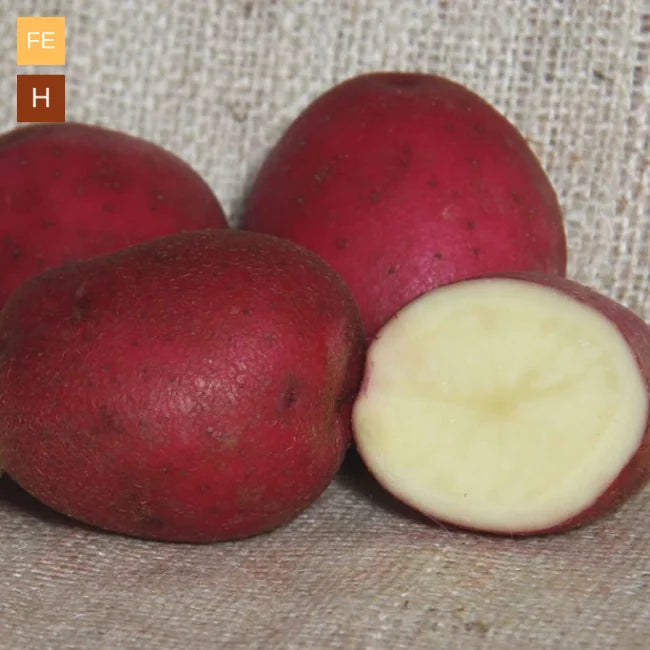Seeds Ireland
Saatkartoffeln: Red Duke Of York (Dieses Produkt und alle weiteren Produkte, die Sie dazu kaufen, werden Ihnen Mitte Februar 2025 geliefert)
- Normaler Preis
- €8.95 EUR
- Normaler Preis
-
- Verkaufspreis
- €8.95 EUR
- Grundpreis
- pro
Verfügbarkeit für Abholungen konnte nicht geladen werden
Wichtig: Dieses Produkt und alle weiteren dazu gekauften Produkte werden Ihnen Mitte Februar 2025 geliefert. Wenn Sie die anderen Artikel jetzt möchten, geben Sie bitte eine separate Bestellung auf.
Name: Saatkartoffeln: Red Duke Of York
Lateinischer Name: Solanum tuberosum
Bio oder konventionell: Konventionell
Menge: 2kg (ca. 15 bis 25 Knollen)
Schnittzeit: Erster Früh
Saatkartoffelgröße: Mindestgrößenklasse 35 mm und Höchstgrößenklasse 60 mm
Herkunft: Irland/Schottland
Beschreibung: Als eine der wenigen frühen Sorten mit leuchtend roter Schale fällt Red Duke of York sowohl im Garten als auch in der Küche auf. Diese Sorte produziert runde, flachäugige Knollen mit cremig gelbem Fleisch und einer Textur, die sich perfekt zum Backen und Braten eignet.
Sie wächst schnell und bringt hohe Erträge und ist deshalb bei Gartenbauern beliebt, insbesondere wenn sie vollständig ausreifen kann, um große, aromatische Früchte zu erhalten. Red Duke of York wurde mit dem RHS Award of Garden Merit ausgezeichnet und gilt als eine der besten Frühsorten, die von Supermärkten und Einzelhändlern immer wieder geschätzt wird.
Kochen: Zum Backen, Kochen, Hacken, Braten.
Pflanz- und Erntezeitpunkt: Frühes Pflanzen im Februar/März für eine Ernte im Mai.
Pflanzen Sie im April für eine Ernte im Juni-Juli.
WIE MAN SAATKARTOFFELN ANBAUT
WO?
Saatkartoffeln können in fast jedem Bodentyp wachsen, aber am besten wachsen sie in tiefen, gut durchlässigen, lehmigen Böden, die nicht zu schwer sind. Diese können mit reichlich organischen Materialien angereichert werden, um Wasser und Nährstoffe zu speichern, damit Ihre Kartoffeln groß und gesund wachsen.
Kartoffeln mögen keinen Frost, daher ist ein Standort mit Südausrichtung und viel Sonne ideal.
Bitte beachten Sie, dass Kartoffeln auch anfällig für eine Vielzahl von Schädlingen sind, darunter Schnecken und Blattläuse.
Wenn Sie jedes Jahr Kartoffeln anpflanzen, sollten Sie diese jedes Jahr an einer anderen Stelle anpflanzen. Dies nennt man Fruchtwechsel. Mindestens 3–4 Jahre sollten vergehen, bevor Sie die Kartoffeln wieder an derselben Stelle anpflanzen. Dies trägt dazu bei, Krankheiten unter den Pflanzen vorzubeugen.
WANN?
Frühkartoffeln , Zweitfrühkartoffeln und Haupternte – diese Begriffe beziehen sich einfach darauf, wie lange es zwischen Pflanzung und Ernte dauert.
Frühsorten – Pflanzen Sie von Februar bis April (wenn das Wetter etwas milder wird), brauchen Sie mindestens 10 Wochen bis zur Reife (13–15 Wochen für mittelfrühe Sorten), ernten Sie etwa im Juni.
Haupternte - Mitte bis Ende April pflanzen, etwa 20 Wochen reifen lassen, ab August ernten. Haupternte nimmt in Ihrem Garten am meisten Platz ein, ist aber die beste Sorte, die Sie für den späteren Verzehr aufbewahren können.
WENN IHRE SAATKARTOFFELN ANKOMMEN
Wenn Sie Ihre Saatkartoffeln erhalten, sollten Sie mit dem Vorkeimen beginnen. Das bedeutet, dass Sie die Kartoffeln zum Keimen anregen. Am besten tun Sie das an einem frostfreien, sonnigen Ort. Eine einfache Methode besteht darin, die Kartoffeln in einem Eierkarton zu lassen, wobei das stumpfe Ende mit den meisten Augen nach oben zeigt. Die kurzen Triebe, die entstehen, helfen den Kartoffeln, nach dem Pflanzen einen guten Start zu haben. Obwohl es für Haupterntesorten nicht unbedingt erforderlich ist, empfehlen wir dringend, Ihre Frühkartoffeln vorzukeimen.
Ideal sind kleine grüne oder violette Triebe mit einer Länge von etwa 2,5 cm. Lange weiße Triebe sind ein Zeichen für zu viel Wärme und zu wenig Licht.
PFLANZEN
Normalerweise beginnt man mit dem Pflanzen, indem man einen V-förmigen Bohrer etwa 12 cm tief in den Boden bohrt. Wenn Sie nur wenig Platz haben und der Boden leicht genug ist, können Sie auch ein Loch bohren und die Kartoffel vorsichtig hineinlegen.
Bei Frühsorten sollte ein Abstand von 24 Zoll zwischen den Reihen eingehalten werden, bei Hauptsorten von 30 Zoll.
Abstand der Samen innerhalb der Reihe: Frühe Samen sollten 12 Zoll voneinander entfernt platziert werden, Haupternte 15 Zoll.
Nachdem Sie die Kartoffeln entlang der Furchen eingepflanzt haben, bedecken Sie jede Kartoffel vorsichtig mit einer Handvoll Torf oder feiner Erde. Achten Sie darauf, die Triebe nicht abzubrechen, sie sind zerbrechlich! Die Kartoffeln sollten mit einer Erdschicht von ca. 7,5 cm bedeckt sein.
Ideal sind kleine grüne oder violette Triebe mit einer Länge von etwa 2,5 cm. Lange weiße Triebe sind ein Zeichen für zu viel Wärme und zu wenig Licht.
AUFHÄUTEN!
Während Ihre Pflanzen wachsen, müssen Sie die Kartoffeln mit Erde oder Erde bedecken, sobald sie über die Oberfläche hinausragen. So verhindern Sie, dass die Knollen durch Lichteinwirkung grün und damit ungenießbar werden.
Sie können auch einige Blätter mit einem Häufeln bedecken. Dies schadet Ihrer Ernte nicht. Wiederholen Sie den Vorgang, bis die Dämme 20 cm hoch sind.
NAHRUNG UND WASSER
Durch die Zugabe von Düngemitteln können die Erträge gesteigert werden. Vermeiden Sie jedoch hohe Stickstoffmengen, da diese die Reife der Pflanzen verzögern.
Kartoffeln lieben Feuchtigkeit, insbesondere wenn sich die Knollen um die Blütezeit herum zu bilden beginnen. Es ist besser, die Pflanzen nicht so oft stark zu wässern, da dies tief in die Wurzeln eindringt.
Niederschlag sollte ausreichend sein, vor allem in Irland! In Dürreperioden sollte jedoch gegossen werden.
ERNTE
Der Erntezeitpunkt hängt vom Pflanzdatum, der Sorte und den Wetterbedingungen während der Saison ab. Im Allgemeinen gilt:
Erste Frühkartoffeln – Wir essen sie gerne frisch geerntet im Juni und Juli in kleinen Mengen.
Zweite Frühsorte – Gleich wie die erste, kleine Mengen werden Ende Juni/Juli frisch verzehrt.
Haupternte – Normalerweise ab September ernten. Achten Sie bei der Lagerung darauf, dass die Knollen gründlich getrocknet sind und in einem atmungsaktiven Sack an einem kühlen, dunklen und trockenen Ort gelagert werden.

Teilen






